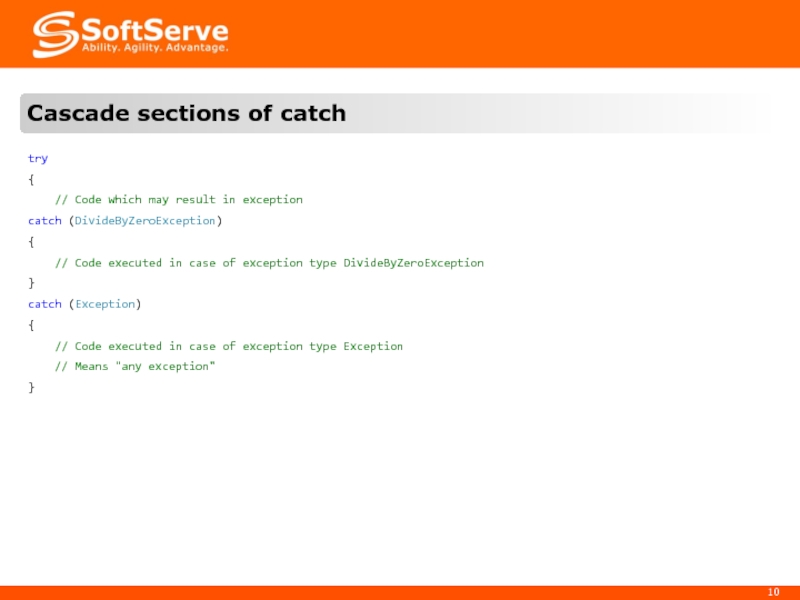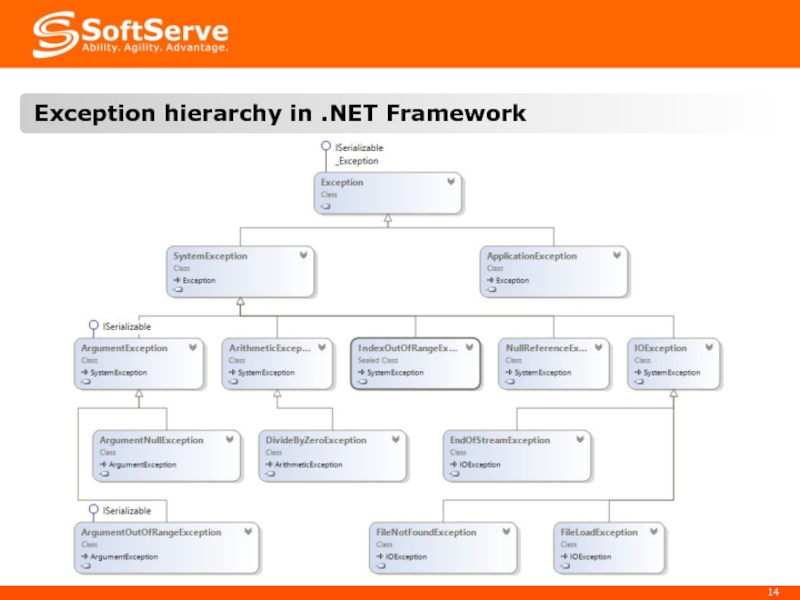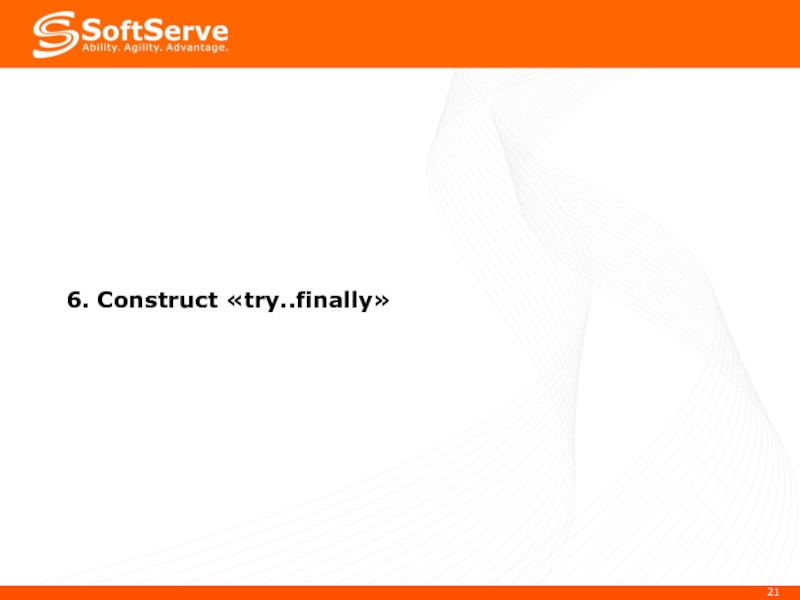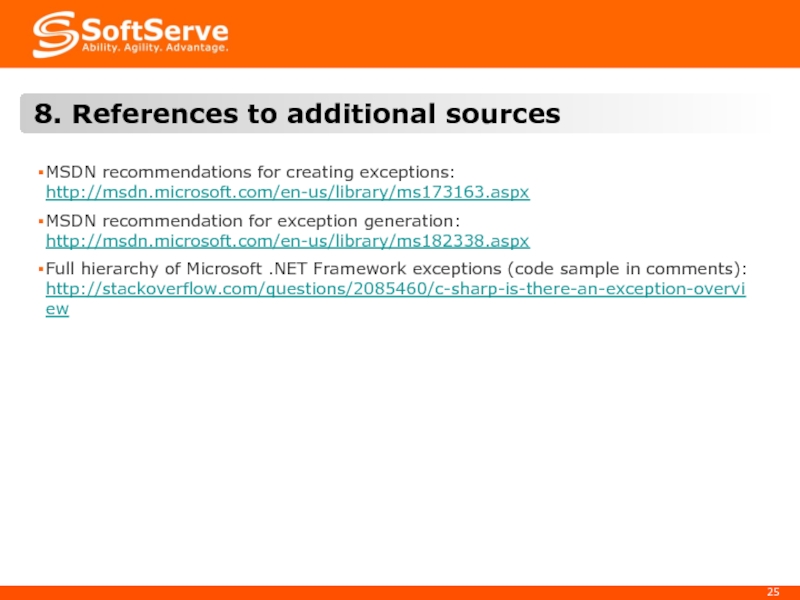- Главная
- Разное
- Дизайн
- Бизнес и предпринимательство
- Аналитика
- Образование
- Развлечения
- Красота и здоровье
- Финансы
- Государство
- Путешествия
- Спорт
- Недвижимость
- Армия
- Графика
- Культурология
- Еда и кулинария
- Лингвистика
- Английский язык
- Астрономия
- Алгебра
- Биология
- География
- Детские презентации
- Информатика
- История
- Литература
- Маркетинг
- Математика
- Медицина
- Менеджмент
- Музыка
- МХК
- Немецкий язык
- ОБЖ
- Обществознание
- Окружающий мир
- Педагогика
- Русский язык
- Технология
- Физика
- Философия
- Химия
- Шаблоны, картинки для презентаций
- Экология
- Экономика
- Юриспруденция
Exception Handling in .NET Framework презентация
Содержание
- 1. Exception Handling in .NET Framework
- 2. Contents Introduction to structured exception handling Construct
- 3. 1. Introduction to structured exception handling
- 4. There are possible situations during the application
- 5. Obsolete error handling method is based on
- 6. Modern way to handle errors provides using
- 7. 2. Construct «try..catch»
- 8. try
- 9. try
- 10. try
- 11. "try..catch" construct with instance of exception
- 12. 3. «Exception» class and exception hierarchy in.NET Framework
- 13. Exception is a base class for all
- 14. Exception hierarchy in .NET Framework
- 15. 4. Exception throwing and re-rising
- 16. Exception throwing public
- 17. Exception re-rising
- 18. 5. Creating own exceptions
- 19. Exception declaration class SampleException:
- 20. MSDN recommendations for exception declarations Minimal possible
- 21. 6. Construct «try..finally»
- 22. «try..finally» used when it is required to
- 23. 7. Best practices for exception handling
- 24. Do not catch general exceptions (do not
- 25. MSDN recommendations for creating exceptions: http://msdn.microsoft.com/en-us/library/ms173163.aspx MSDN
- 26. Thank you! www.softservecom.com Copyright © 2014
Слайд 2Contents
Introduction to structured exception handling
Construct «try..catch»
«Exception» class and exception hierarchy in.NET
Exception throwing and re-rising
Creating own exceptions
Construct «try..finally»
Best practices for exception handling
References to additional sources
Слайд 4There are possible situations during the application execution when predetermined plan
Developer should provide ways to ensure correct execution despite possible errors
Main task – correct operation of the application
There are different kinds of errors reactions on which may be different and some may be corrected and some – don't:
Software errors created by developer like reading of non-initialized variable;
System errors and failures with resources, like memory exhaustion and file read errors;
User errors like incorrect data input.
Слайд 5Obsolete error handling method is based on multiple checks of input
Drawbacks:
difficulties;
bloated code;
unreliable.
Obsolete check-based method
int IOResult = ReadFileWithIOResult("somefile.txt");
if (IOResult != 0)
{
// Exception here, action required
}
else
{
// File read successfully continuing normal execution
}
Слайд 6Modern way to handle errors provides using of special mechanism –
Exception is an event which happens during software execution and changes normal way of code execution
Exceptions in .NET Framework are instances of classes inherited from base class Exception. Only instances of this class and inherited classes may participated in structured exception handling.
Structured exception handling
Слайд 8 try
// Code which may result in exception
}
catch
{
// Code executed only in case of exception
}
Simplest "try..catch" constuct
Слайд 9 try
// Code which may result in exception
}
catch (DivideByZeroException)
{
// Code executed in case of exception
}
"try..catch" construct with specific exception
Слайд 10 try
// Code which may result in exception
catch (DivideByZeroException)
{
// Code executed in case of exception type DivideByZeroException
}
catch (Exception)
{
// Code executed in case of exception type Exception
// Means "any exception"
}
Cascade sections of catch
Слайд 11"try..catch" construct with instance of exception
{
// Code which may result in exception
}
catch (Exception e)
{
// Code executed in case of exception
// Using object e to get access to properties of exception
Console.WriteLine(e.Message);
// Re-rising same exception
throw;
}
Слайд 13Exception is a base class for all exceptions исключений
Important properties:
Message –
Source – name of an error source (application or object)
InnerException – inner exception (if called from other)
StackTrace – call stack to the point of exception call
TargetSite – method name which raised an exception
HelpLink – URL-address to information about exception
Data – dictionary with additional information with exception (IDictionary)
Exception class
Слайд 16Exception throwing
public static void Demo(string SomeRequiredArg)
// Check if some required argument is null
if (SomeRequiredArg == null)
{
// Exception throwing
throw new ArgumentNullException("Argument SomeRequiredArg is null");
}
}
Слайд 17Exception re-rising
try
// Code which may rise an exception
}
catch (Exception e)
{
// Exception handling code
// Using object e to get access to exception properties
Console.WriteLine(e.Message);
// Rising same exception again
throw;
}
Слайд 19Exception declaration
class SampleException: ApplicationException { };
It is recommended to
Simplest declaration:
class SpecificSampleException: SampleException { };
To declare specific exceptions developers should create hierarchies of exceptions:
Слайд 20MSDN recommendations for exception declarations
Minimal possible declaration for exception declaration described
default constructor;
constructor which sets Message property;
constructor which sets Message and InnerException properties;
constructor for serialization.
[Serializable()]
public class InvalidDepartmentException : ApplicationException
{
public InvalidDepartmentException() : base() { }
public InvalidDepartmentException(string message) : base(message) { }
public InvalidDepartmentException(string message, System.Exception inner) : base(message, inner) { }
// A constructor is needed for serialization when an
// exception propagates from a remoting server to the client.
protected InvalidDepartmentException(System.Runtime.Serialization.SerializationInfo info,
System.Runtime.Serialization.StreamingContext context) { }
}
Слайд 22«try..finally» used when it is required to guarantee execution of some
May be used together with catch
Using finally
try
{
// Code which may raise an exception
}
finally
{
// Code which should be executed on any condition
}
Слайд 24Do not catch general exceptions (do not use catch without parameters
Create own exceptions based on ApplicationException class but not on SystemException
Do not use exceptions for application execution control flow as exception handling is heavy resource usage task. Exceptions should be used to manage errors only
Do not mute exceptions which can’t be handled in application context (system errors and failures).
Do not raise general exceptions: Exception, SystemException, ApplicationException
Do not generate reserved system exceptions: ExecutionEngineException, IndexOutOfRangeException, NullReferenceException, OutOfMemoryException
Do not return an exception instance as a method return result instead of using throw.
Do not create exceptions used only for debugging purposes. Do define debug-only exceptions use Assert.
Best practices for exception handling
Слайд 25MSDN recommendations for creating exceptions:
http://msdn.microsoft.com/en-us/library/ms173163.aspx
MSDN recommendation for exception generation:
http://msdn.microsoft.com/en-us/library/ms182338.aspx
Full hierarchy of
8. References to additional sources
Слайд 26Thank you!
www.softservecom.com
Copyright © 2014 SoftServe, Inc.
Contacts
Europe Headquarters
52 V. Velykoho Str.
Lviv
Tel: +380-32-240-9090 Fax: +380-32-240-9080
E-mail: info@softservecom.com
US Headquarters
13350 Metro Parkway, Suite 302
Fort Myers, FL 33966, USA
Tel: 239-690-3111
Fax: 239-690-3116
E-mail: info@softservecom.com































